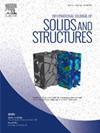Design and crashworthiness evaluation of corrugated honeycomb with multi-directional energy absorption capacity
Abstract
In this study, three novel multi-directional energy-absorbing honeycombs were designed to meet the requirements in the crash of uncertain directions, which are named as bow-shaped honeycomb (BSHC), staggered honeycomb (SGHC) and corrugated honeycomb (CGHC). These innovative designs can significantly narrow the huge gap of the energy absorption capacity between the in-plane and out-of-plane directions of traditional honeycombs. Compression tests were conducted in three orthogonal directions. The BSHC is found to have the smallest densification strain but the highest plateau stress in each direction. The SGHC can only balance the energy absorption between out-of-plane and in-plane-x directions. The CGHC demonstrates a better densification strain and the highest multi-directional energy absorption coefficient. The detailed and equivalent finite element models of CGHC were further established and validated, and both exhibited high accuracy. Finally, a honeycomb anti-climber, with only about half length of the traditional guided honeycomb anti-climber, was designed and equipped with metro vehicles. Simulations were conducted under eccentric collision scenario. The results demonstrated that the CGHC anti-climber was capable of orderly deformation in the axial direction (out-of-plane direction) while effectively resisting the vertical (in-plane-y direction) force during collision. The energy absorption capacity of CGHC anti-climber was significantly enhanced as compared to the HEHC anti-climber under eccentric collision scenario.

 求助内容:
求助内容: 应助结果提醒方式:
应助结果提醒方式:


